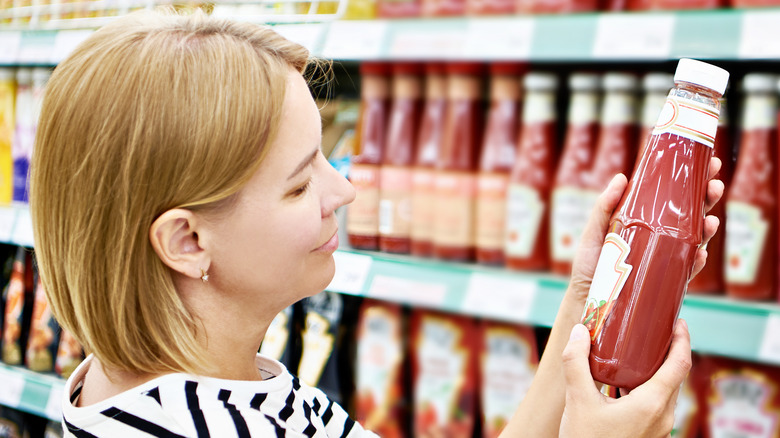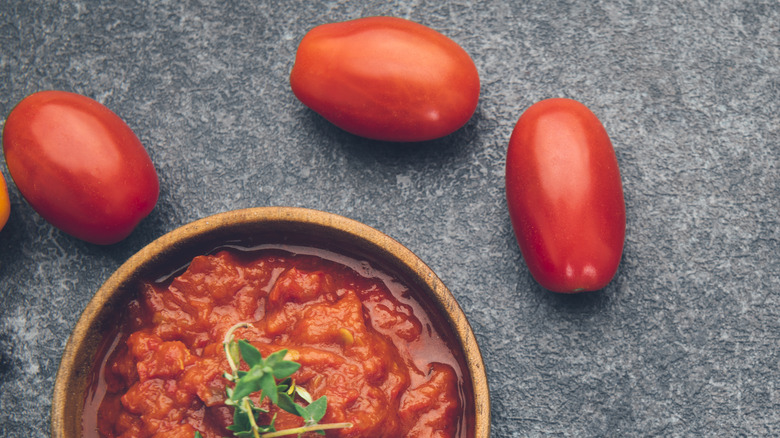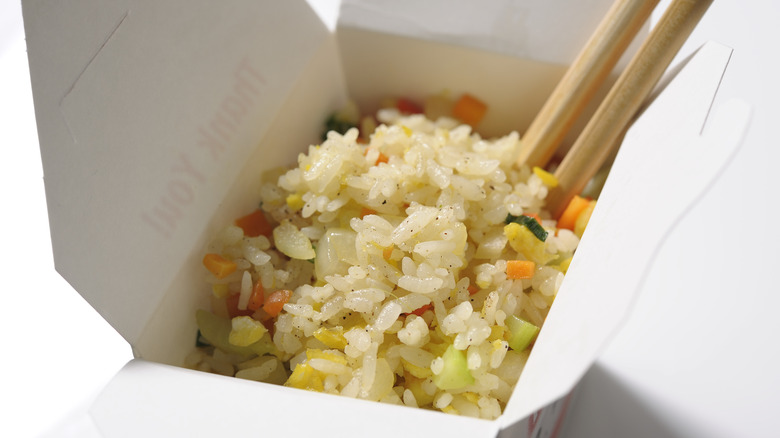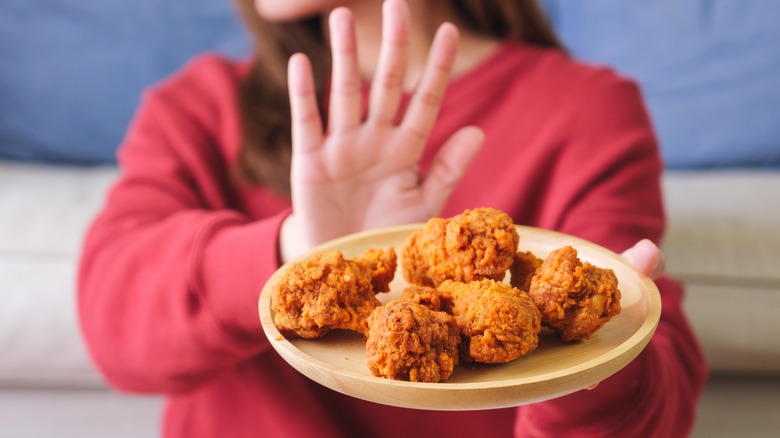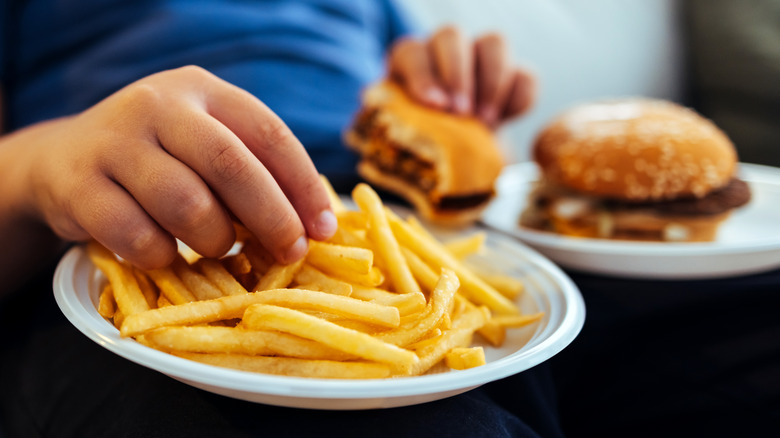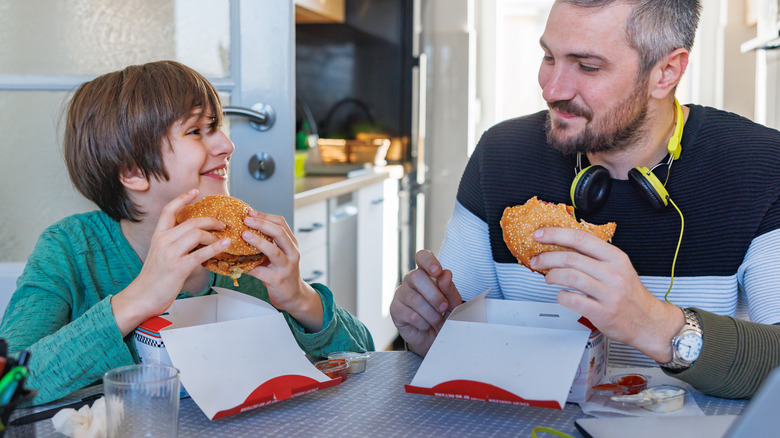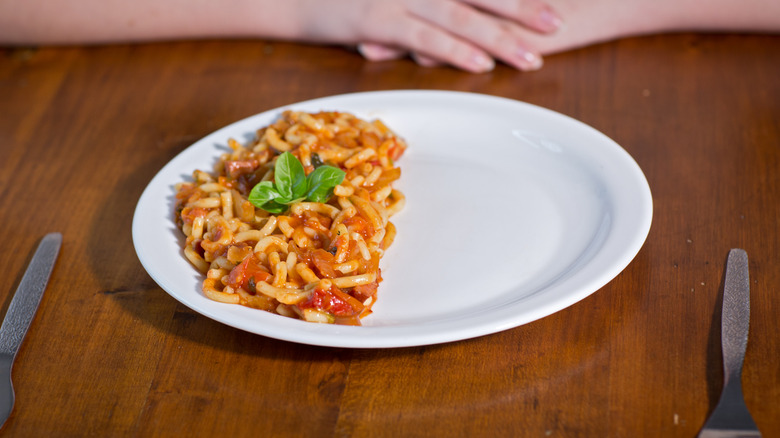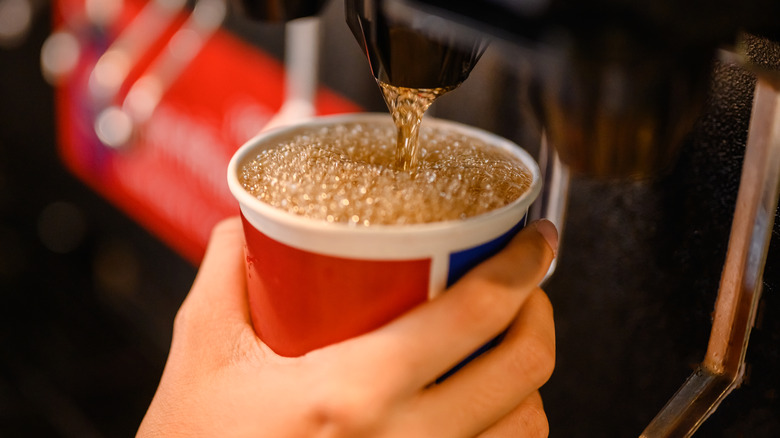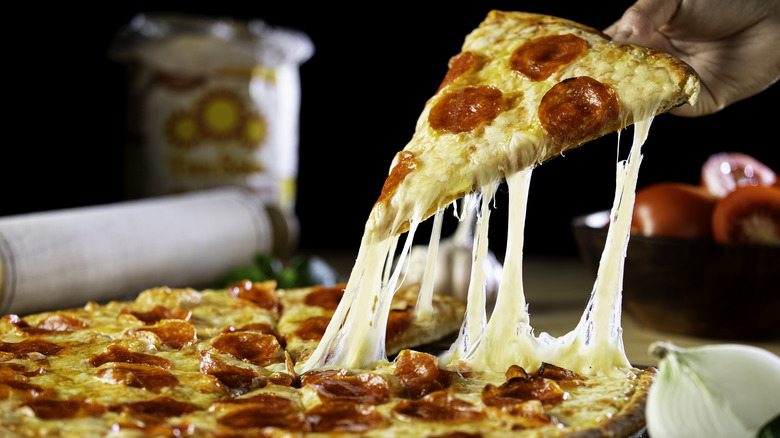Try These 9 Healthy Food Hacks The Next Time You Order Takeout
If you don't like to cook, you're not alone. Eddie Yoon, researcher and author of the book "Superconsumers," told Harvard Business Review in 2017 that over a 15-year period, he saw the number of Americans who love to cook drop from 15% to 10%. Those who hated cooking also dropped during this time from 50% to 45% while those who only liked to cook sometimes rose from 35% to 45%.
What's noteworthy is that, per Yoon, people who only like to cook sometimes and people who hate cooking both turn to restaurants for meals, including ordering takeout. So, as of 2017, around 90% of Americans had incorporated takeout meals into their regular lives. But while more Americans are getting their meals to go, takeout itself isn't new. As Time notes, as middle class America grew after WWII and television became more popular, restaurants found themselves losing business, and so adjusted with the times by promoting takeout options. This doesn't mean takeout didn't exist before this point, but it did reach a whole new level of availability and popularity.
Today, getting takeout can be as easy as order food on an app (via Time). But just because takeout is convenient doesn't mean it's always the healthiest option. Of course, how healthy a takeout meal is varies from food establishment to food establishment, but there are some simple ways to help takeout fit your health needs.
Use your own condiments
It's common for restaurants to include condiment packets with a takeout order. And sometimes condiments are already on food (for example, a sandwich with mayo). But these extra bursts of flavor aren't always the healthiest options, especially in large amounts.
According to Food Network, the recipe for a common takeout condiment, ketchup, typically includes spices, salt, pepper, vinegar, and, of course, tomatoes. But while ketchup contains vitamins like A and C, as well as an antioxidant called lycopene, it can also be a source of sugar and sodium. Tomatoes naturally have sugar, but the majority of sugar found in ketchup is added sugar. For instance, it's not uncommon for companies to use high-fructose corn syrup in their ketchup — and just eight tablespoons of ketchup can contain the maximum amount of sodium one should consume in a day. Ketchup is also not the only condiment that might make a meal less healthy: A tablespoon of mayonnaise can have as much as 12 grams of fat.
If you can't imagine your favorite takeout meal without condiments, consider ordering it plain and adding your own. As Food Network points out, you might want to opt for one of the organic ketchups on the market or even make your own ketchup. Moreover, by not ordering a condiment already on a food, you can also control how much you use.
Opt for vegetable-based (not cream-based) sauces
There are times when you won't be able to control what sauce or how much of that sauce is on your takeout meal (for example, if you order a slice of pizza to go). But when you can choose a sauce (such as for a takeout pasta dish), there are healthier options.
As the Cleveland Clinic recommends, if you have a choice between a vegetable-based sauce or a cream-based one, the vegetable-based sauce is typically the better choice. According to Today, cream is a common ingredient for modern Alfredo sauce along with butter and Parmigiano cheese. Classic marinara sauce contains no cream, and its basic recipe consists of tomatoes, garlic, onions, and spices, per Merriam-Webster. And while tomatoes are technically fruits, they are also categorized as vegetables, via Britannica. The Pasta Shop makes both of these sauces, and 100 grams of their Alfredo sauce has 26.7 grams of fat and 127 milligrams of cholesterol (via USDA). Meanwhile, 100 grams of The Pasta Shop's marinara sauce contains just 4.42 grams of fat and no cholesterol (per USDA).
Even if you pick a vegetable-based sauce, the Cleveland Clinic notes that takeout meals sometimes contain large amounts of sauce, which can make them less healthy. But you can request the restaurant go light on the sauce or just put the sauce on the side, so you can control the amount. Also, you can ask for no sauce and just use your own.
Choose the best rice for your health needs
Rice is a common menu option for takeout. And chances are, you've heard that you should choose brown rice over white rice because it's healthier. However, depending on your health needs, that's not always the right move.
As GoodRx explains, grains like rice have three main parts: the bran, the germ, and the endosperm. But while brown rice keeps all three of these parts, manufacturers remove the germ and the bran from rice when they are producing white rice. Because of this, brown rice is higher in nutrients and fiber. And while fiber is usually recommended as part of a healthy diet, it's typically advised to choose foods that have lower amounts of fiber (like white rice) if you have health issues like Crohn's disease, inflammatory bowel disease (IBD), or ulcerative colitis. This is also the case for patients who have recently had bowel surgery.
Besides white and brown rice, another common takeout food is fried rice. But while the ingredients can vary for fried rice, the ingredient choices and just the fact that the rice is fried can raise this rice dish's sodium, calories, and fat (via MedicineNet). For example, a cup of white rice fried in vegetable oil can have more than 700 milligrams of sodium. So, if you want rice as part of your takeout order, opt for it boiled instead of fried.
Pick grilled foods over fried foods
According to the Cleveland Clinic, a good rule of thumb if you want to make a takeout item healthier is to not order it fried. And while there are different preparation options depending on the food and your personal preferences, grilling rather than frying is definitely one possible healthier alternative.
As Wesley Enhanced Living explains, frying foods increases their fat content. This is why fried foods can increase one's cholesterol and lead to such health problems as hypertension, cardiovascular disease, type 2 diabetes, and stroke. Fried foods also have larger amounts of calories. Plus, even healthy foods like vegetables can lose nutritional content when they're fried. This is because in order to traditionally fry foods, they need to be cooked in hot oil, which can lower the amount of vitamins in the food. However, grilled vegetables don't need to be cooked as long, and so they retain more of their vitamins. Also, fat runs out of meat when it's grilled, meaning you consume lower amounts of fat. Plus, grilling typically leads to foods that have fewer calories.
If you aren't a fan of grilled foods, the Cleveland Clinic suggests trying a dish roasted, baked, or steamed instead of fried. Other healthier than frying options include poached, boiled, and broiled, via USDA. And even if an item on a takeout menu is listed as fried, don't hesitate to ask if it's available grilled or baked.
Don't choose French fries for your side dish
USDA research from 2019 shows that potatoes are one of the most widely eaten vegetables in the United States. This is in part because of the popularity of French fries. But just because these common takeout side dishes are popular doesn't mean they're healthy.
Dr. Britt Burton-Freeman, director of the Center for Nutrition Research at the Illinois Institute of Technology, told Time that potatoes themselves aren't an issue to eat on a regular basis as long as they're prepared in a healthy way. But as Dr. Jonathan Bonnet, a family medicine resident physician at Duke University, explained to Time, a good portion of the fiber and nutrients in potatoes come from their skins. Since frying potatoes involves peeling them, this lowers their nutritional value. Additionally, Wesley Enhanced Living notes that frying vegetables decreases their vitamin content. Plus, frying foods in general increases the amount of fat in them. Take, for example, a medium order of drive-thru French fries. According to Time, they can contain 17 grams of fat, 365 calories, and 246 milligrams of sodium.
If you're looking for an alternative to French fries, the Cleveland Clinic recommends swapping them out for a baked potato. Not only is baking a healthier way to prepare foods than frying, but you'll also have the potato's nutrient- and fiber-packed peel. Just be careful about what toppings you use.
Is red meat an acceptable takeout option?
From hamburgers and roast beef sandwiches to steak dinners, red meat is a common takeout item. But over the years, there has been debate and red flags raised about red meat.
A study from 2019 concluded that there is "low evidence" that red meat and processed meat are harmful to human health (via Harvard Health Publishing). However, Dr. Frank Hu, chair of the Department of Nutrition at Harvard, refuted the researchers' findings, stating that the study suffered from a "flawed methodology and a misinterpretation of nutritional evidence." Per Dr. Hu, multiple studies have found connections between consuming large amounts of red meat and processed meats and health problems like diabetes, heart disease, and cancer, as well as a shorter lifespan. With that said, consuming lower amounts of red meat doesn't appear to carry the same level of health risk. And while there is some question as to how much red meat a person should eat, Dr. Hu notes that a maximum of two to three servings a week is generally recommended.
If you want to include red meat in your takeout order (and in your diet in general), Dr. Hu recommends thinking of it as an occasional luxury rather than an everyday meal. It may also help to make red meat a side dish rather than the main course.
Don't finish everything on your plate
To be clear, we're not suggesting that you waste food. But as the American Heart Association points out, sometimes a single meal from a restaurant is large enough to last for more than one meal. This is why it's important to understand the difference between a portion of food and a serving of it.
Chances are you've already seen the term "serving" when it comes to food, since Nutrition Facts labels include what is considered a serving for a particular food (via American Heart Association). Portions, however, refer to how much of a certain food you consume in one sitting. For example, a serving of bread is typically one slice. So, if you're having a sandwich, then your portion of bread is two slices, which is two servings. When it comes to pasta, a single serving is usually half a cup when the pasta is cooked. One serving of cooked rice is also half a cup. For common proteins like fish, meat, and poultry, a serving is from two to three ounces; cheese is typically two ounces per serving.
Since exercising proper portion control means taking the serving size of foods into consideration, you might want to look up the serving sizes of your favorite takeout foods. And, as the USDA suggests, you can divide a takeout meal into smaller meals that can be shared or refrigerated and saved for another time.
Don't order regular or diet soda
The American Heart Association has recommendations for healthier drink options, like water, when you order takeout. However, two common takeout drinks, soda and diet soda, aren't listed, and considering the negative impacts these beverages can have on one's health, that's not surprising.
According to UCLA, there's evidence that drinking regular soda every day can raise the chances of becoming a type 2 diabetic. There are also findings that soda is connected to health issues like heart disease, obesity, hypertension, and high cholesterol. Delta Dental notes that soda could lead to fatty liver disease and a greater likelihood of developing cancer. Also, soda's sugar is food for the bacteria in one's mouth, which can result in oral health problems. Plus, the sugar and caffeine in some sodas can be a bad combination. Caffeine alone can cause dehydration, while sugar can cause dehydration to happen more quickly. Once you're dehydrated, you can experience dry mouth, which can raise the risk of cavities. Caffeine can be found in tea and coffee, even though they're both on the American Heart Association's list of healthier takeout drink options. So, you might want to drink water with either of these beverages.
Although diet soda doesn't have the sugar content of regular soda, UCLA points out that it can have a negative impact on one's metabolism. And the acid in diet soda (which is also in regular soda) can be bad for your teeth, via Delta Dental.
Pick healthy pizza toppings
According to Time, takeout pizza's popularity in the U.S. can be traced back to the 1940s. In addition to takeout food's availability and popularity growing at this time, members of the military came back to the States wanting more of the Italian cuisine they had experienced while overseas during WWII. But as Dr. Caroline Cederquist, a board-certified physician in family practice and functional medicine, told Men's Health, typical restaurant and frozen pizzas tend to be "high in calories, simple carbohydrates, sugar, sodium, and fat."
In addition, registered dietitian nutritionist Anna Smith cautions that a pizza's toppings (e.g., ham, pepperoni, and sausage) can make it a less healthy option. However, registered dietitian Amy Kimberlain told Everyday Health that loading up pizza with vegetables is a good way to increase its nutrient and fiber content. For example, broccoli is packed with vitamins A, C, E, and K, as well as B vitamins like B6, folate, niacin, riboflavin, and thiamin, via WebMD. It's also a good source of minerals like zinc, phosphorus, calcium, potassium, and iron. Plus, broccoli has fiber. Peppers are also a good choice; no matter what kind you choose, you'll get a good dose of nutrients like vitamin C and potassium, as well as fiber (per WebMD).
If you want to add a little protein to your pizza, Food Network suggests picking healthier toppings, like grilled chicken. You can also do a combination of vegetables and healthy protein.


